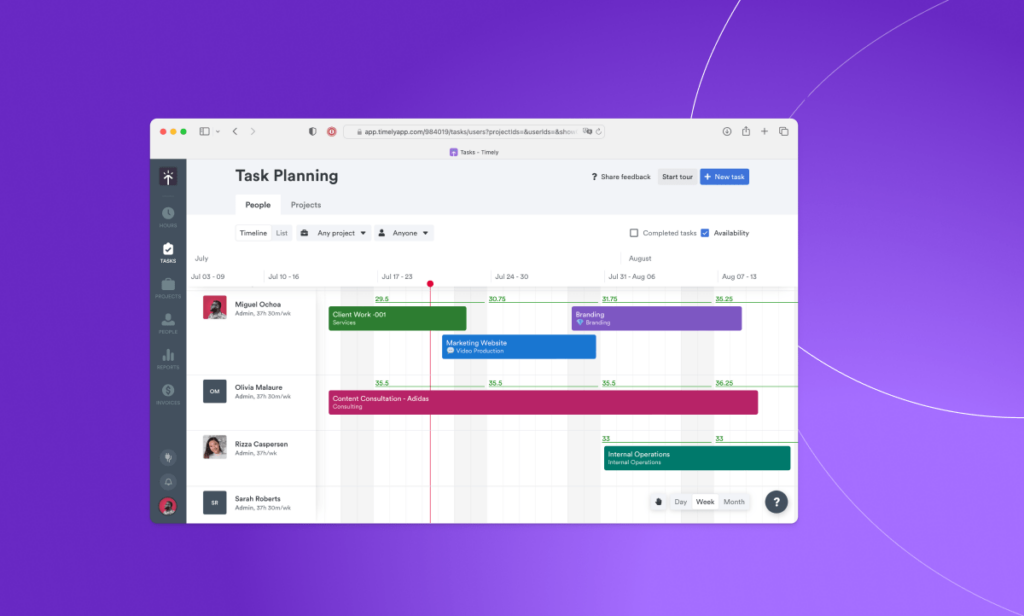Successful projects are based on the foundation of the discipline of project management. Use project management tools and strategies on any scale. From building the largest architectural wonders to launching a new software program, they ensure that you meet your goals. This in-depth investigation of project management aims to expose the fundamental principles that guide this discipline and demonstrate its inherent worth in a variety of fields and efforts.
Table of Contents
The Purpose of Project Management Tools
The goal of project management goes beyond merely finishing a task; it depends on the three factors of time, cost, and quality. Essentially, project management aims to complete projects on schedule, within budget, and in accordance with predetermined quality standards. Additionally, it aims to manage the project’s scope properly while minimizing changes, which will satisfy all project stakeholders, from clients and team members to end-users or customers.

The Role of the Project Manager
Every successful project has a project manager at its head, who is the key figure in organizing resources, navigating challenges, and ensuring project coherence. The job description of a project manager covers a wide range of duties, including thorough project planning, team building, resource management, choosing project management tools, scope management, and effective stakeholder communication.
Project Initiation
Project initiation is the process through which a project sponsor or the management of an organization turns a notion, business requirement, or opportunity into a project. At this stage, evaluate the project’s viability and feasibility. At this pivotal stage, assess if the project is in line with the strategic goals of the business. Also, check if you have the required resources.
Key Components of Project Initiation:
Project Charter
The fundamental document approving the project’s existence is the project charter. It provides the project manager with crucial direction by outlining the project’s goals, scope, stakeholders, risks, and limitations.
Stakeholder Identification
It is crucial to recognize and comprehend the project’s stakeholders. A stakeholder is anyone involved in the project. This covers team members, external clients, or regulatory organizations.
Feasibility Study
The project’s viability is investigated in a feasibility study. This involves determining the organizational, financial, scheduling, and technical viability.
Project Team Selection
During initiation, the project manager starts putting the project team together. This includes selecting people who have the necessary abilities and skills to carry out the project’s goals.
Initial Scope Description
The initial scope definition offers a high-level overview of the project’s objectives, while the project’s ultimate scope is described afterwards. It aids in controlling stakeholder expectations.
Project Execution
The crunch time comes during the project execution phase. The actual work is the culmination of all the planning and preparation. During this phase, the project team puts out the most effort, uses the most resources, and closely monitors progress.
Key Components:
Resource Allocation
Resources, including staff, supplies, machinery, and finances, are distributed during execution in accordance with the project plan. To achieve project goals, efficient resource management is essential.
Task Implementation
The project timetable is followed for all project activities. This entails delegating tasks to team members, monitoring output, and making sure that activities are finished on schedule and within the parameters specified.
Quality Control
To make sure that project deliverables satisfy predetermined quality standards, quality control methods are put in place. To do this, routine testing and inspections may be carried out.
Risk Management
While hazards are identified during the planning stage, continued risk management is required during execution. Unexpected risks are quickly addressed in order to keep them from derailing the project.
Communication
Effective communication is essential. Stakeholders are kept up to date on the status of the project as well as any problems that require attention through regular status meetings, reports, and updates.
Change Management
Changes might be required as the project moves forward. Analyze, authorize, and incorporate changes with the least amount of disturbance possible. Then, put change management processes in place.
Issue Resolution
Quickly resolve any problems or obstacles that develop during execution. The project stays on schedule and avoids delays through effective issue resolution.
Project Monitoring and Control
Project management’s watchtower is project monitoring and control. Its managers and teams keep a close check on various parts of the project throughout this phase to make sure it adheres to the plan and achieves its goals. Monitoring progress, recognizing problems, and making required adjustments are the main goals of this phase.

Key Components of Project Management Tools:
Performance Measurement
Use the project plan to gauge project progress. Evaluate the project’s status using key performance indicators (KPIs).
Issue Identification
Stakeholders and project teams keep an eye out for problems or departures from the plan. This can involve blown budgets, missing deadlines, or poor quality issues.
Change Management
Evaluate the impact of any suggested modifications to the project scope, timeline, or budget. Control changes formally, using a change management procedure.
Risk Management
Monitor ongoing risks. Evaluate and modify plans for handling new hazards.
Quality Control
Make sure project deliverables satisfy the necessary requirements. Perform quality checks and inspections.
Reporting
Keep stakeholders up-to-date on the status of the project. Distribute regular status reports and updates.
Scope Management
Closely manage the project’s scope, and ensure that it stays within its predetermined bounds.
Project Closure and Evaluation
The pinnacle of project management is project closure. It’s the stage where you carry out all the effort, planning, carrying out, and monitoring. At this point, the project is complete, and the team assesses its success. Evaluation is the process of comparing the project’s overall performance and results to its predetermined goals.
Key Components:
Deliverable Acceptance
The stakeholders evaluate and formally accept each project’s output.
Final Reporting
Produce a thorough project report that summarizes the project’s journey, successes, difficulties, and lessons learned.
Resource Release
Liberate team members, tools, and facilities from their obligations.
Financial Closure
Resolve the financial parts of the project, including budget reconciliation and account closing.
Lessons Learned
The team holds a lessons learned session to consider what worked and what didn’t, as well as suggestions for future improvement.
Stakeholder Handover
The appropriate stakeholders get a formal handover of the project’s results and deliverables.
Agile Project Management Tools & Techniques
Agile project management represents a paradigm shift from conventional practices. Agile, as opposed to conventional, linear techniques, accepts change as a necessary component of the project path. Its methodologies emphasize teamwork, agility, and customer-centricity.
Agile approaches include Scrum, Kanban, Extreme Programming (XP), and others. They place a higher value on people and interactions, practical solutions, customer collaboration, and adapting to change than they do on formal procedures and documentation.
User stories, sprint cycles, daily stand-ups, and retrospectives are characteristics of agile projects. User stories offer succinct descriptions of functionality from the viewpoint of the end user. Sprints, which last two to four weeks on average, guarantee regular progress evaluations. Daily stand-ups help teams communicate better, while retrospectives encourage ongoing improvement.
Greater flexibility, customer focus, quicker time to market, greater quality, improved team cooperation, and decreased risk are all advantages of agile project management. Scope creep, difficult resource allocation, cultural transformations, and the demanding nature of ongoing client interaction are nevertheless obstacles.
Agile’s future looks bright. It is still developing, and its concepts apply to a wide range of sectors besides software. Its suitability for distributed teams and remote work emphasizes its applicability in the current business environment.
To sum up, Agile project management provides a flexible framework for navigating the complexity of contemporary projects. Agile helps teams provide value effectively by embracing flexibility, collaboration, and customer-centricity.
Hybrid Project Management
A new strategy known as hybrid project management is gaining popularity in the current project management environment. This methodology combines the best aspects of traditional and Agile approaches. It provides a flexible framework, tailored to specific demands.
While other initiatives necessitate iterative flexibility, some demand formal planning. Hybrid management brings these together.
Pragmatism serves as the foundational premise of hybrid project management. Recognizing that a one-size-fits-all strategy frequently fails, it strives to strike the ideal balance between structure and adaptability. Hybrid projects combine Waterfall, Agile, or other methods to meet certain needs.
Integrating agile methods, such as Scrum or Kanban, into a project framework that is mostly Waterfall is a typical example of hybrid project management. In order to facilitate quicker delivery and customer collaboration, teams can maintain a linear, phase-driven approach for some parts while utilizing Agile principles for others.
The hybrid approach has several advantages, including improved risk management, increased stakeholder participation, increased project execution flexibility, and the capacity to adapt project management methodologies to particular requirements. However, it’s crucial to keep in mind that hybrid projects demand competent project managers that are familiar with both conventional and Agile methodologies.
Hybrid project management appears to have a bright future as businesses look for flexible frameworks that can handle a variety of project portfolios. It promotes a way of thinking that favors pragmatism over orthodoxy and encourages project managers to use the best tools and methods for each particular task.
Finally, hybrid project management provides a practical answer for contemporary projects that do not cleanly fit into traditional or agile models. Hybrid helps project managers optimize processes, reduce risks, and produce successful results in an ever-changing project landscape by fusing the capabilities of many techniques. It will become more popular as businesses look for innovative project management methods.
Tools and Software
Trello
Trello is a well-liked option for teams using Agile or Kanban approaches because of its clarity and visual attractiveness. Users can create boards for projects, lists for tasks, and cards for specific assignments using the card-based system. Trello’s drag-and-drop design makes it simple to prioritize tasks and track progress, and the app’s interaction with Slack and Google Drive improves teamwork.

Microsoft Project
Microsoft Project is a top option for individuals looking for a powerful project management application with sophisticated scheduling and resource management features. It helps users design Gantt charts, distribute resources, and keep rigorous track of project timeframes. It could have a longer learning curve, but it’s a strong tool for businesses handling complex projects.
Jira
An industry-recognized tool for Agile software development projects is Jira, created by Atlassian. Teams can easily manage tasks, sprints, and releases because of its outstanding issue and project tracking capabilities. Jira meets a variety of project management requirements, after some customization.
Slack
Project management depends on effective communication, and Slack is a pioneer in this field. Real-time chat, file sharing, and interfaces with several project management and productivity tools are all features of this collaboration platform. Teams can communicate and stay updated with Slack, which eliminates the need for lengthy email threads.
Case Studies
In the realm of project management tools, theory and strategy are essential, but it’s often real-world case studies that truly illustrate the effectiveness of various methodologies and tools. Let’s delve into a selection of case studies that highlight how different organizations, both large and small, have employed project management techniques to overcome challenges and achieve remarkable results. These real-life stories serve as practical guides and demonstrate how project management principles can be adapted to diverse industries and scenarios.
Agile Transformation at a Tech Startup
To respond swiftly to market changes, a dynamic tech startup transitioned from traditional project management to Agile methodologies. This involved cross-functional teams, iterative development, and constant customer feedback. The result? Accelerated product launches, a significant increase in customer satisfaction, and a culture of adaptability.
Construction Project Management Mastery
In the construction industry, where tight schedules and budgets are the norm, effective project management is critical. Here, a construction company streamlined its operations with lean project management. By eliminating waste, optimizing workflows, and employing digital collaboration tools, they achieved remarkable cost savings and completed projects well ahead of schedule.
Reviving a Troubled Project with Waterfall
Agile is not suitable for all projects. A large government initiative was on the brink of failure. A project management team with extensive experience in Waterfall methodologies took charge. Through meticulous planning, rigorous documentation, and comprehensive risk management, they not only rescued the project but also delivered it within budget and ahead of schedule.
Bridging the Gap with Hybrid Project Management Tools
Some projects require a hybrid approach that combines elements of Agile and Waterfall. A marketing campaign that demanded both flexibility and detailed planning. By implementing a hybrid project management strategy, the team was able to respond swiftly to market feedback while ensuring that the campaign adhered to the established brand guidelines.
Scaling Up with Portfolio Management
For large enterprises juggling multiple projects simultaneously, portfolio management is indispensable. A multinational corporation optimized its project portfolio. By aligning projects with strategic objectives, eliminating redundancy, and optimizing resource allocation, they achieved a significant boost in overall efficiency and profitability.
The Ongoing Journey
The journey is just as important as the destination in the world of project management tools. Technology improvements, shifting market conditions, and the need for increased efficiency and effectiveness are all driving forces behind the field’s ongoing evolution. As we come to a close with our examination of project management methodologies, it is critical to think critically about the broad ideas that guide effective project management as well as the way forward for both novice and seasoned project managers.
The Ever-Evolving Landscape
Project management is a dynamic discipline that adjusts to the shifting business environment, not a static one. Its leaders are using cutting-edge software, AI, and data analytics today to improve decision-making, streamline procedures, and obtain deeper insights into project performance.
A variety of industries use these tools, including marketing, construction, and information technology. This cross-industry applicability emphasizes how adaptable project management tools are.
Continuous Learning and Professional Development
The field of project management emphasizes lifelong learning and development. Project managers can confirm their knowledge and keep up with industry best practices by earning recognized certifications like PMP (Project Management Professional) and PRINCE2 (Projects in Controlled Environments).
The Road Ahead
Project management is still a crucial discipline for corporate goals in a time of rapid change and complexity. So, the path never ends. Accept innovation, change with the times, and continuously improve your project management tools. The capacity to oversee successful projects in a changing environment is essential.
Looking for a knowledgeable partner to help you with your creative project management? Book a call with us and let’s discuss!
FAQs
- What is the difference between project management and program management?
Project management focuses on completing a specific project within defined scope, time, and budget. Program management involves overseeing multiple related projects to achieve broader business goals.
- How do you measure project success beyond time, cost, and quality?
Project success can also be evaluated based on stakeholder satisfaction, business impact, return on investment (ROI), and the long-term benefits delivered.
- What are the biggest challenges in project management, and how can they be addressed?
Common challenges include scope creep, resource constraints, poor communication, and unexpected risks. These can be managed through clear documentation, stakeholder engagement, regular risk assessments, and effective change control.
- How can small teams or startups apply project management without complex tools?
Small teams can use simple frameworks like Kanban or Scrum with lightweight tools like Trello or Notion. Regular check-ins and prioritization meetings help maintain focus without excessive documentation.
- What are the best certifications for project managers?
Popular certifications include PMP (Project Management Professional), PRINCE2, Certified Scrum Master (CSM), and PMI-ACP (Agile Certified Practitioner). The best choice depends on industry needs and career goals.



















